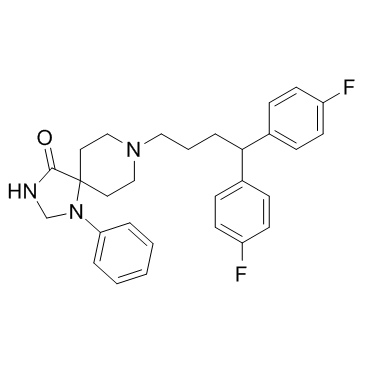Inhibition of glutamate release by fluspirilene in cerebrocortical nerve terminals (synaptosomes).
Su-Jane Wang
文献索引:Synapse 44(1) , 36-41, (2002)
全文:HTML全文
摘要
Fluspirilene, a neuroleptic drug which is used clinically to treat schizophrenic patients, is a dopamine D2 receptor antagonist. Besides its well-known actions on the dopamine receptors, fluspirilene also displays calcium channel-blocking activity. The aim of this study was to investigate the effect of fluspirilene on the 4-aminopyridine (4AP)-evoked glutamate release in the cerebrocortical nerve terminals (synaptosomes). Fluspirilene reduced 4AP-evoked glutamate release in a concentration-dependent manner. This inhibitory effect was associated with a decrease in the depolarization-evoked increase in the cytoplasmic free Ca2+ concentration ([Ca2+]C), which could be completely abolished by the Ca2+ channel blocker omega-CgTX GVIA. Furthermore, fluspirilene did not produce any effect on ionomycin-evoked glutamate release. These results suggest that fluspirilene inhibits glutamate release primarily by reducing presynaptic Ca2+ influx via N-type Ca2+ channels in rat cerebrocortical nerve terminals. This finding implies that presynaptic Ca2+ channel blockade concomitant with inhibition of glutamate release and possibly other neurotransmitters release may contribute to the antischizophrenic action of fluspirilene.Copyright 2002 Wiley‐Liss, Inc.
相关化合物
| 结构式 | 名称/CAS号 | 分子式 | 全部文献 |
|---|---|---|---|
 |
氟司必林
CAS:1841-19-6 |
C29H31F2N3O |
|
Small molecule regulators of autophagy identified by an imag...
2007-11-27 [Proc. Natl. Acad. Sci. U. S. A. 104 , 19023-8, (2007)] |
|
Determination of fluspirilene in human plasma by liquid chro...
1998-12-18 [J. Chromatogr. A. 828(1-2) , 219-27, (1998)] |
|
Test therapy in the treatment of generalized anxiety disorde...
1995-10-01 [Prog. Neuropsychopharmacol. Biol. Psychiatry 19(6) , 1049-60, (1995)] |
|
A crystallographic and molecular modeling study of butyrophe...
1998-12-01 [J. Pharm. Sci. 87(12) , 1496-501, (1998)] |
|
Grief hallucinations: true or pseudo? Serious or not? An inq...
2002-01-01 [Psychopathology 35(5) , 296-302, (2002)] |